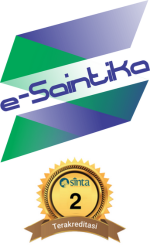Effectiveness of Hybrid Learning Model Against Student HOTS in Learning Microbiology at IKIP Budi Utomo
Abstract
Keywords
Full Text:
PDFReferences
Andreeva, N. M., Artyukhov, I. P., Myagkova, E. G., Pak, N. I., & Akkasynova, Z. K. (2018). Organizing blended learning for students on the basis of learning roadmaps. Journal of Social Studies Education Research, 9(2), 47–64. https://doi.org/10.17499/jsser.81426
Aprilia, R., Rustana, C. E., & Budi, E. (2020). Pengaruh Pemanfaatan Media Phet Dalam Pembelajaran Jarak Jauh Menggunakan Webinar Zoom Terhadap Peningkatan High Order Thinking Skills (Hots) Siswa Fisika Sma. IX, 177–182. https://doi.org/10.21009/03.snf2020.02.pf.26
Bin Mubayrik, H. (2018). The present and future state of blended learning at workplace-learning settings in adult education: A systematic review. Journal of Social Studies Education Research, 9(4), 247–273. https://doi.org/10.17499/jsser.41308
Eliyasni, R., Kenedi, A. K., & Sayer, I. M. (2019). Blended Learning and Project Based Learning: The Method to Improve Students’ Higher Order Thinking Skill (HOTS). Jurnal Iqra’ : Kajian Ilmu Pendidikan, 4(2), 231–248. https://doi.org/10.25217/ji.v4i2.549
Erni, S., Vebrianto, R., Miski, C. ut R., Z, Z. A. M., Martinus, & Thahir, M. (2020). Refleksi proses pembelajaran dimasa pendemi Covid 19 di Pekanbaru: Dampak dan solusi. Bedelau: Journal of Education and Learning, 1(1), 1–10. https://ejournal.anotero.org/index.php/bedelau/article/view/1
Fariska, R., & Erman. (2017). Blended Learning Untuk Meningkatkan Level Kemampuan Berpikir Kritis. Pensa: Jurnal Pendidikan Sains, 5(02), 60–66.
Fraenkel, J. R., Wallen, N. E., & Hyun, H. H. (2012). How to Design and Evaluate Research in Education (EIGHTH EDI). McGraw-Hill, a business unit of The McGraw-Hill Companies,.
Hajar, Y., Yanwar, R., Jalaludin, M. A., Achmad, N., Indriani, G. S., Hidayat, W., & Rohaeti, E. E. (2018). Analisis Kemampuan High Order Thinking (HOT) Siswa SMP Negeri di Kota Cimahi. JPMI-Jurnal Pembelajaran Matematika Inovatif, 1(3), 453–458. https://doi.org/10.22460/jpmi.v1i3.453-458
Hartanto, W. (2016). Penggunaan E-Learning sebagai Media Pembelajaran. Jurnal Pendidikan Ekonomi, 10(1), 1–18.
Kacetl, J., & Semradova, I. (2020). Reflection on blended learning and e-learning – case study. Procedia Computer Science, 176, 1322–1327. https://doi.org/10.1016/j.procs.2020.09.141
Maulia Fatimahtuzzahroh, A., Mustadi, A., & Nur Wangid, M. (2021). Implementation HOTS Based-Learning during Covid-19 Pandemic in Indonesian Elementary School. Jurnal Pendidikan Progresif, 11(1), 96–111. https://doi.org/10.23960/jpp.v11.i1.202109
Nasrullah, R., Aditya, W., Satya, T. I., Nento, M. N., Hanifah, N., Miftahussururi, & Akbari, Q. S. (2017). Materi Pendukung Literasi Digital. In Kementerian Pendidikan dan Kebudayaan. http://gln.kemdikbud.go.id/glnsite/wp-content/uploads/2017/10/literasi-DIGITAL.pdf
Nirahua, J., Taihuttu, J., & Sopacua, V. (2020). Pengembangan Bahan Ajar Berbasis Blended Learning Dan Critical Thinking Skill Pada Mata Kuliah Astrofisika Dalam Menyongsong Era Revolusi Industri 4.0. Jambura Physics Journal, 2(1), 24–36. https://doi.org/10.34312/jpj.v2i1.6869
Novikov, P. (2020). Impact of COVID-19 Emergency Transition to On-line learning on International Students’ Perceptions of Educational Process at Russian University. Journal Of Sosial Studies Educations Research, 11(3), 270–302. https://doi.org/10.2214/AJR.17.19405
Nuraini, S., Wayan Distrik, I., Suana, W., Soemantri Brojonegoro No, J., & Lampung, B. (2018). Pengembangan Lembar Kerja Siswa Blended Learning Berorientasi Higher Order Thinking Skilss Development of Blended Learning Student Worksheet Oriented With Higher Order Thinking Skills. Journal of Physics and Science Learning, 02(1), 69–77.
Rahayu, S. (2020). The Effectiveness of New Inquiry-Based Learning (NIBL) for Improving Multiple Higher-Order Thinking Skills (M-HOTS) of Prospective Chemistry Teachers. European Journal of Educational Research, 9(3), 1309–1325. https://doi.org/10.12973/eu-jer.9.3.1309
Sambite, F. C. ., Mujasam, M., Widyaningsih, S. W., & Yusuf, I. (2019). Penerapan Project Based Learning berbasis Alat Peraga Sederhana untuk Meningkatkan HOTS Peserta Didik. Berkala Ilmiah Pendidikan Fisika, 7(2), 141. https://doi.org/10.20527/bipf.v7i2.6310
Shams, I. E. (2013). Hybrid Learning and Iranian EFL Learners’ Autonomy in Vocabulary Learning. Procedia - Social and Behavioral Sciences, 93, 1587–1592. https://doi.org/10.1016/j.sbspro.2013.10.086
Soler, R., Soler, J. R., & Araya, I. (2017). Diagnosis of Educational Needs for the Implementation of Blended Courses Based on the Blended Learning Model. The Case of the Social Sciences Faculty of the National University of Costa Rica. Procedia - Social and Behavioral Sciences, 237, 1316–1322. https://doi.org/10.1016/j.sbspro.2017.02.216
Trung, N. T., Thu, T. T. L., & Tan, L. M. (2012). Replacing Face-To-Face Classes by Synchronous Online Technologies: The HOU Experience. Procedia - Social and Behavioral Sciences, 67(November 2011), 386–392. https://doi.org/10.1016/j.sbspro.2012.11.342
Utama, C., Sajidan, & Nurkamto, J. (2020). The Instrument Development to Measure Higher-Order Thinking Skills for Pre-Service Biology Teacher. International Journal of Instruction, 13(4), 833–848. https://www.e-iji.net/dosyalar/iji_2020_4_51.pdf
Wahyuni, A. S. (2021). Penerapan model hybrid learning dalam PTM terbatas untuk meningkatkan motivasi dan hasil belajar siswa. Indonesian Journal of Educational Development, 2(3), 472–481. https://doi.org/10.5281/zenodo.5681376
Yustina, Syafii, W., & Vebrianto, R. (2020). The effects of blended learning and project-based learning on pre-service biology teachers’ creative thinking skills through online learning in the COVID-19 pandemic. Jurnal Pendidikan IPA Indonesia, 9(3), 408–420. https://doi.org/10.15294/jpii.v9i3.24706
DOI: https://doi.org/10.33394/j-ps.v10i3.5174
Refbacks
- There are currently no refbacks.
Copyright (c) 2022 Purwaning Budi Lestari, Tri Asih Wahyu Hartati, Budijanto Budijanto

This work is licensed under a Creative Commons Attribution 4.0 International License.

J-PS (Prisma Sains: Jurnal Pengkajian Ilmu dan Pembelajaran Matematika dan IPA IKIP Mataram) p-ISSN (print) 2338-4530, e-ISSN (online) 2540-7899 is licensed under a Creative Commons Attribution 4.0 International License.








 https://orcid.org/0000-0003-4395-5221
https://orcid.org/0000-0003-4395-5221